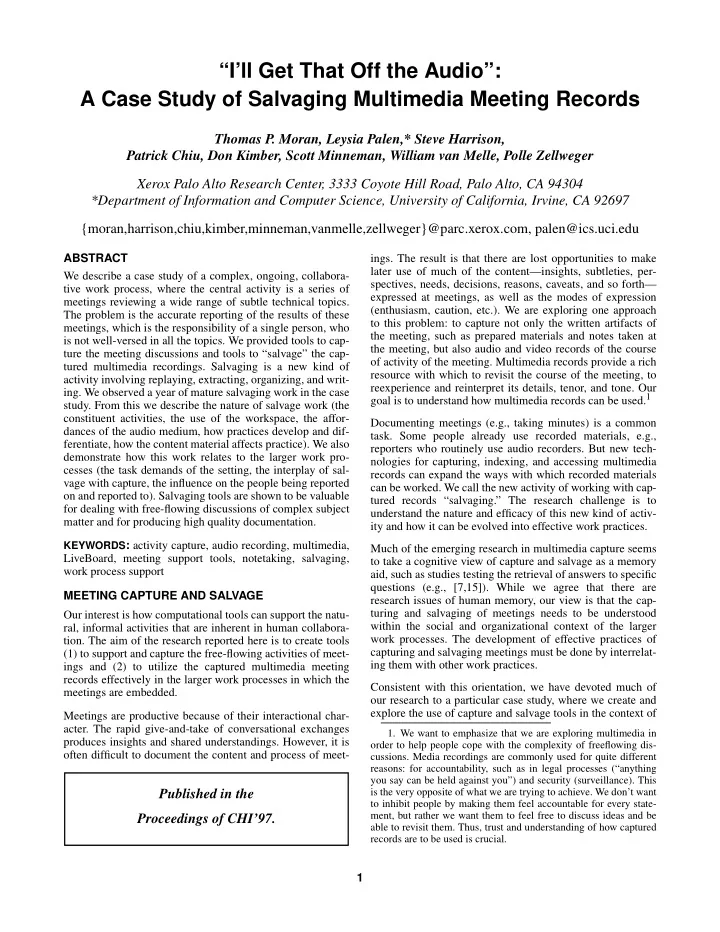

“I’ll Get That Off the Audio”: A Case Study of Salvaging Multimedia Meeting Records Thomas P. Moran, Leysia Palen,* Steve Harrison, Patrick Chiu, Don Kimber, Scott Minneman, William van Melle, Polle Zellweger Xerox Palo Alto Research Center, 3333 Coyote Hill Road, Palo Alto, CA 94304 *Department of Information and Computer Science, University of California, Irvine, CA 92697 {moran,harrison,chiu,kimber,minneman,vanmelle,zellweger}@parc.xerox.com, palen@ics.uci.edu ABSTRACT ings. The result is that there are lost opportunities to make later use of much of the content—insights, subtleties, per- We describe a case study of a complex, ongoing, collabora- spectives, needs, decisions, reasons, caveats, and so forth— tive work process, where the central activity is a series of expressed at meetings, as well as the modes of expression meetings reviewing a wide range of subtle technical topics. (enthusiasm, caution, etc.). We are exploring one approach The problem is the accurate reporting of the results of these to this problem: to capture not only the written artifacts of meetings, which is the responsibility of a single person, who the meeting, such as prepared materials and notes taken at is not well-versed in all the topics. We provided tools to cap- the meeting, but also audio and video records of the course ture the meeting discussions and tools to “salvage” the cap- of activity of the meeting. Multimedia records provide a rich tured multimedia recordings. Salvaging is a new kind of resource with which to revisit the course of the meeting, to activity involving replaying, extracting, organizing, and writ- reexperience and reinterpret its details, tenor, and tone. Our ing. We observed a year of mature salvaging work in the case goal is to understand how multimedia records can be used. 1 study. From this we describe the nature of salvage work (the constituent activities, the use of the workspace, the affor- Documenting meetings (e.g., taking minutes) is a common dances of the audio medium, how practices develop and dif- task. Some people already use recorded materials, e.g., ferentiate, how the content material affects practice). We also reporters who routinely use audio recorders. But new tech- demonstrate how this work relates to the larger work pro- nologies for capturing, indexing, and accessing multimedia cesses (the task demands of the setting, the interplay of sal- records can expand the ways with which recorded materials vage with capture, the influence on the people being reported can be worked. We call the new activity of working with cap- on and reported to). Salvaging tools are shown to be valuable tured records “salvaging.” The research challenge is to for dealing with free-flowing discussions of complex subject understand the nature and efficacy of this new kind of activ- matter and for producing high quality documentation. ity and how it can be evolved into effective work practices. KEYWORDS : activity capture, audio recording, multimedia, Much of the emerging research in multimedia capture seems LiveBoard, meeting support tools, notetaking, salvaging, to take a cognitive view of capture and salvage as a memory work process support aid, such as studies testing the retrieval of answers to specific questions (e.g., [7,15]). While we agree that there are MEETING CAPTURE AND SALVAGE research issues of human memory, our view is that the cap- turing and salvaging of meetings needs to be understood Our interest is how computational tools can support the natu- within the social and organizational context of the larger ral, informal activities that are inherent in human collabora- work processes. The development of effective practices of tion. The aim of the research reported here is to create tools capturing and salvaging meetings must be done by interrelat- (1) to support and capture the free-flowing activities of meet- ing them with other work practices. ings and (2) to utilize the captured multimedia meeting records effectively in the larger work processes in which the Consistent with this orientation, we have devoted much of meetings are embedded. our research to a particular case study, where we create and explore the use of capture and salvage tools in the context of Meetings are productive because of their interactional char- acter. The rapid give-and-take of conversational exchanges 1. We want to emphasize that we are exploring multimedia in produces insights and shared understandings. However, it is order to help people cope with the complexity of freeflowing dis- often difficult to document the content and process of meet- cussions. Media recordings are commonly used for quite different reasons: for accountability, such as in legal processes (“anything you say can be held against you”) and security (surveillance). This is the very opposite of what we are trying to achieve. We don’t want Published in the to inhibit people by making them feel accountable for every state- ment, but rather we want them to feel free to discuss ideas and be Proceedings of CHI’97. able to revisit them. Thus, trust and understanding of how captured records are to be used is crucial. 1
Recommend
More recommend